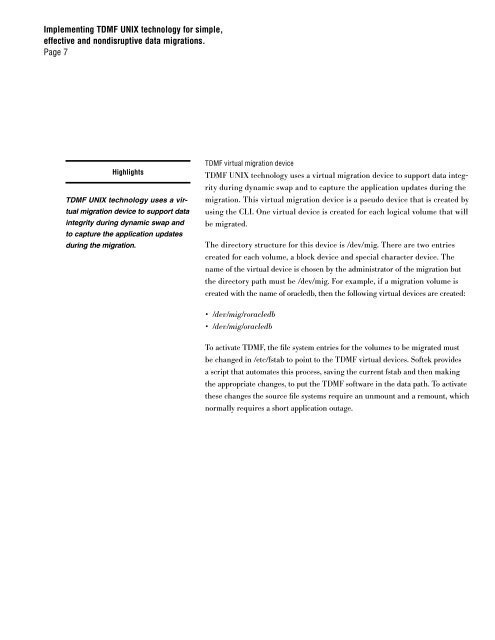Implementing TDMF UNIX technology for simple, effective and ... - IBM
Implementing TDMF UNIX technology for simple, effective and ... - IBM Implementing TDMF UNIX technology for simple, effective and ... - IBM
Implementing TDMF UNIX technology for simple, effective and nondisruptive data migrations. Page 6 Highlights The TDMF solution consists of three components: CLI, filter driver and configuration files. TDMF architecture TDMF consists of three components: • Command line interface (CLI): provides a user interface to issue commands and control migrations • Filter driver: captures application updates during the data migration • Configuration files: contains system and migration configuration details referenced by the TDMF software. The TDMF software is transparent to the application(s) running on the application server. Since the TDMF driver is located between the file systems and the volume manager, there are no driver, microcode or multipathing dependencies. Figure 1 TDMF architecture Application server (host) TDMF CLI TDMF TDMF config files App File system Softek TDMF filter driver Volume manager
Implementing TDMF UNIX technology for simple, effective and nondisruptive data migrations. Page 7 Highlights TDMF UNIX technology uses a virtual migration device to support data integrity during dynamic swap and to capture the application updates during the migration. TDMF virtual migration device TDMF UNIX technology uses a virtual migration device to support data integrity during dynamic swap and to capture the application updates during the migration. This virtual migration device is a pseudo device that is created by using the CLI. One virtual device is created for each logical volume that will be migrated. The directory structure for this device is /dev/mig. There are two entries created for each volume, a block device and special character device. The name of the virtual device is chosen by the administrator of the migration but the directory path must be /dev/mig. For example, if a migration volume is created with the name of oracledb, then the following virtual devices are created: • /dev/mig/roracledb • /dev/mig/oracledb To activate TDMF, the file system entries for the volumes to be migrated must be changed in /etc/fstab to point to the TDMF virtual devices. Softek provides a script that automates this process, saving the current fstab and then making the appropriate changes, to put the TDMF software in the data path. To activate these changes the source file systems require an unmount and a remount, which normally requires a short application outage.
- Page 1 and 2: IBM Global Technology Services Dece
- Page 3 and 4: Implementing TDMF UNIX technology f
- Page 5: Implementing TDMF UNIX technology f
- Page 9 and 10: Implementing TDMF UNIX technology f
- Page 11 and 12: Implementing TDMF UNIX technology f
- Page 13 and 14: Implementing TDMF UNIX technology f
- Page 15 and 16: Implementing TDMF UNIX technology f
- Page 17 and 18: Implementing TDMF UNIX technology f
- Page 19 and 20: Implementing TDMF UNIX technology f
<strong>Implementing</strong> <strong>TDMF</strong> <strong>UNIX</strong> <strong>technology</strong> <strong>for</strong> <strong>simple</strong>,<br />
<strong>effective</strong> <strong>and</strong> nondisruptive data migrations.<br />
Page 7<br />
Highlights<br />
<strong>TDMF</strong> <strong>UNIX</strong> <strong>technology</strong> uses a virtual<br />
migration device to support data<br />
integrity during dynamic swap <strong>and</strong><br />
to capture the application updates<br />
during the migration.<br />
<strong>TDMF</strong> virtual migration device<br />
<strong>TDMF</strong> <strong>UNIX</strong> <strong>technology</strong> uses a virtual migration device to support data integrity<br />
during dynamic swap <strong>and</strong> to capture the application updates during the<br />
migration. This virtual migration device is a pseudo device that is created by<br />
using the CLI. One virtual device is created <strong>for</strong> each logical volume that will<br />
be migrated.<br />
The directory structure <strong>for</strong> this device is /dev/mig. There are two entries<br />
created <strong>for</strong> each volume, a block device <strong>and</strong> special character device. The<br />
name of the virtual device is chosen by the administrator of the migration but<br />
the directory path must be /dev/mig. For example, if a migration volume is<br />
created with the name of oracledb, then the following virtual devices are created:<br />
• /dev/mig/roracledb<br />
• /dev/mig/oracledb<br />
To activate <strong>TDMF</strong>, the file system entries <strong>for</strong> the volumes to be migrated must<br />
be changed in /etc/fstab to point to the <strong>TDMF</strong> virtual devices. Softek provides<br />
a script that automates this process, saving the current fstab <strong>and</strong> then making<br />
the appropriate changes, to put the <strong>TDMF</strong> software in the data path. To activate<br />
these changes the source file systems require an unmount <strong>and</strong> a remount, which<br />
normally requires a short application outage.



